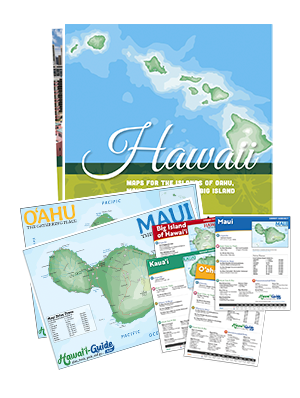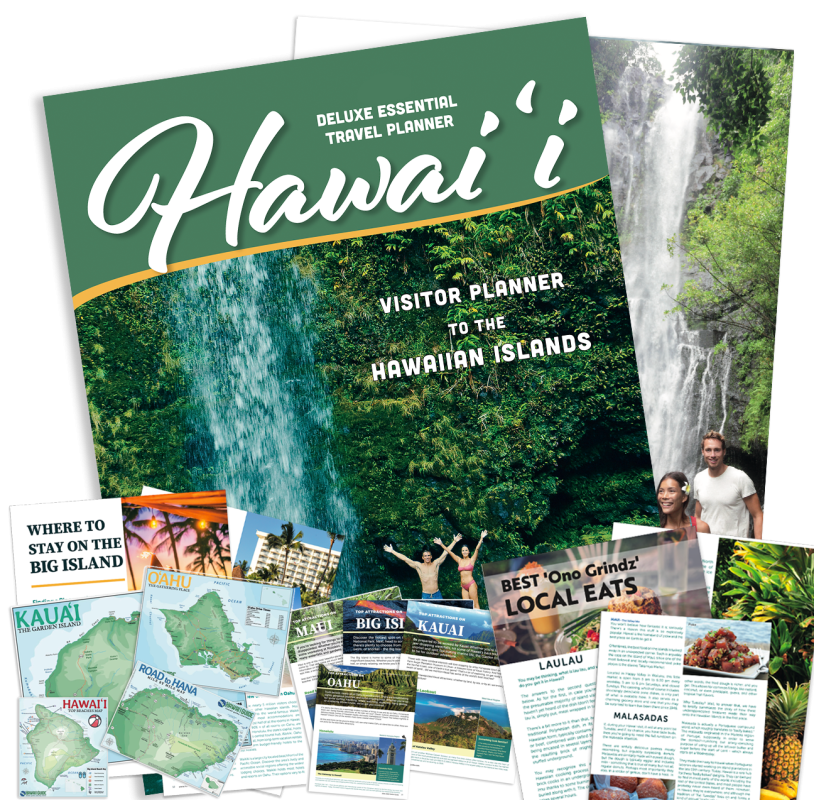Hawaii Airports
One of the World's Busiest Airports
Oahu, also known as The Gathering Place, is home to the majority of Hawaii's population and is famous for its beautiful beaches, surfing, and historical sites. And if you plan to visit the sights there, you'll very likely be passing through one of the world's busiest airports- Honolulu International Airport (HNL).
Located just 5 miles northwest of downtown Honolulu and 10 miles northwest of Waikiki Beach, Honolulu International Airport is praised by passengers for being easy to navigate, efficient, and clean. Kudos also go out to the friendly airport employees who embody the Spirit of Aloha, as well as the facility's many open-air areas. So, let's explore the airport's history and what makes it such a great airport experience today.
— article continued below —
2024 Oahu Visitor Guides
Visiting Oahu soon? Be sure to grab your copy of one of our updated Oahu Visitor Guides.
~ Trusted by Millions of Hawaii Visitors Annually ~
In 1925, monies were appropriated for an airport/landing field on the island, and part of a private estate was acquired. Later that same year, Commander John Rodgers and his crew attempted to complete the first flight across the Pacific from the U.S. Mainland to Hawaii. They ran out of fuel about 365 miles from Oahu and crashed into the Pacific. The heroic party crafted sails from the plane's wings and set sail toward land. Their food was gone by day three, and their water supply exhausted by day six. Luckily, on day ten, they spotted Kauai and soon met with a submarine which towed them safely ashore, where they were welcomed as heroes. Despite their forced landing, they held the new world record for a Trans-Pacific flight that stood for nearly five years.
Because of this amazing feat, in 1927, the John Rodgers Airport was dedicated in honor of the pioneering aviator. Work continued at the facility over the years, and the site expanded and improved.
After the attack on Pearl Harbor, the military took control of all Territorial airports. Throughout WWII, the airport underwent several modifications to accommodate the needs of the military. In 1946, John Rodgers Airport was returned to the Territory and was renamed Honolulu Airport. The word 'international' was added to its name in 1951. Construction and expansion continued over the years, and a new terminal was dedicated in 1962. Since then, the Honolulu International Airport has continually expanded and modernized to meet ever-increasing demands.
Today, the airport occupies 4,520 acres and has four active runways- including the impressive Reef Runway, which measures 12,000 feet and is the first major runway in the world to be built entirely offshore. It is served by 27 domestic and international carriers, four commuter airlines, and three inter-island airlines. Approximately 50,000 passengers per day utilize the facility.
Such a large number of visitors necessitates a wide range of amenities, and the Honolulu International Airport certainly fits the bill. Travelers enjoy a variety of retail stores, souvenir shops, coffee shops, newsstands, fresh flowers and lei sales, bars, and clothing and accessory shops. There is also a food court, business center, currency exchange, ATMs, medical clinic, electronic device charging stations, and 15 Visitor Information Program desks ready to assist travelers. And, although we hope you do not have an occasion to stop by, the airport even has a jail.
Oahu Rental Cars
Also, there are eight different federal government agencies with a presence within the facility, including the FAA, Department of Agriculture, U.S. Customs and Border Protection, DEA, Fish and Wildlife Service, U.S. Post Office, TSA, and the CDC.
Finding transportation at the Honolulu International Airport is a snap, and you have several options. There are six rental car agencies at the facility, with four more located nearby. Or, if you prefer a taxi, they are conveniently located in front of the baggage claim areas. Another option is the handy SpeediShuttle, which provides door-to-door service to your hotel, home, or office. Of course, there are many other pre-arranged ground transportation providers that service the airport. Public transportation is also available; city buses depart approximately every 30 minutes.
Honolulu International Airport is accessible to travelers with disabilities, as is most ground transportation. Porter Services are available upon request and can assist with boarding, disembarking, and public transportation. Also, a free intra-airport shuttle makes several stops throughout the facility. Curbside loading and unloading are also available, and there are several TTYs for the deaf and hard of hearing. The airport also welcomes guide/service dogs.
There are several things to do at the Honolulu International Airport while you wait for your flight. As mentioned, shopping and dining options are plentiful. If you prefer, relax and enjoy the free Hawaiian entertainment in the lobby. Or maybe you're in the mood for a little greenery- if so, you'll love the cultural gardens located throughout several sites. Designed by Richard C. Tongg in 1962, these gardens reflect Hawaiian, Japanese, and Chinese influences and provide a welcome respite for weary travelers. The three gardens are connected by bridges, stepping stones, and pathways, while the flowing waterways represent the confluence of cultures in Hawaii. There are also several lovely sculptures.
You'll also want to admire the works of art located throughout the facility. The State Foundation on Culture and the Arts have commissioned several pieces, from murals to free-standing sculptures.
Another unique piece to appreciate is the Statehood Mosaic, which is made of artwork by students grades K-12 from across the U.S. in order to commemorate the 50th anniversary of Hawaii's statehood. The colorful, happy scenes are a reflection of what the students cherish about the great state of Hawaii.
Speaking of the great state of Hawaii, many people have worked tirelessly to enhance the quality of life not only in the Pacific Asia region but throughout the world. In order to honor these dedicated individuals, the Pacific Asia Travel Association (PATA) has honored them in the airport's Gallery of Legends. Take some time to reflect on the noble contributions the honorees have made.
History buffs will certainly want to pay particular attention in the Atrium area, as there is a three-quarter scale model of an Army P-12/Navy F-4 hanging from the ceiling; this was the last bi-plane made during the inter-war period. Directly underneath the model plane, you'll find a 20'x20' terrazzo floor map of Oahu which shows the airfields and airstrips that existed towards the end of WWII. There are also photos of early planes that flew in Hawaii. After checking those out, direct your gaze upwards once again to admire the Sikorsky S-43 "Baby Clipper" model airplane. Prior to 'landing' at the Honolulu International Airport, it was displayed at the Pacific Aerospace Museum- which later grew into the Pacific Aviation Museum of Pearl Harbor.
Also, on your way through the south side of the Central Concourse, don't miss the model PN-9 Navy aircraft used by John Rodgers and his crew during their historic flight.
As airports go, the Honolulu International Airport most certainly has a wide range of services and amenities that make it a positive experience; one which should only improve moving forward, as there major improvements in the works. The ultimate goal is to move the airport into the ranks of a world-class facility over the next few years in order to enhance the visitor experience and meet increasing demands. Hopefully, you'll soon be able to check out everything HNL has to offer.
Honolulu Oahu Airport Map
Search Flights to Oahu
You May Also be Interested In...


















